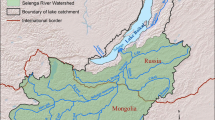Abstract
Effective management of tidal wetlands requires periodic data on the boundaries, extent, and condition of the wetlands. In many states, wetlands are defined wholly, or in combination with other criteria, by the presence of particular emergent halophytic plants. Many important characteristics of the wetlands ecosystem are related directly to the production of emergent plant material or may be inferred from knowledge of the distribution of emergent plant species. Remote-sensing techniques have been applied to mapping of the distribution of wetland vegetation but not to quantitative evaluation of the condition of that vegetation.
Recent research in the tidal wetlands of Delaware and elsewhere has shown that spectral canopy reflectance properties can be quantitatively related to the emergent green biomass ofSpartina alterniflora (salt marsh cord grass) throughout the peak growing season (April through September, in Delaware). Periodic measurements of this parameter could be applied to calculations of net aerial primary productivity for large areas ofS. alterniflora marsh in which conventional harvest techniques may be prohibitively time consuming. The method is species specific and, therefore, requires accurate discrimination ofS. alterniflora from other vegetation types. Observed seasonal changes in species spectral signatures are shown to have potential for improving multispectral categorization of tidal wetland vegetation types.
Similar content being viewed by others
Literature cited
Anderson, R. R., V. Carter, and J. McGinness. 1973. Applications of ERTS to coastal wetland ecology with special reference to plant community mapping and impact of man. Pages 1225–1242in Proc. 3rd ERTS Symp. Washington, D.C.
Anderson, R. R., and F. J. Wobber. 1973. Wetlands mapping in New Jersey. Photogram. Eng. 39(4): 353–358.
Bankston, P. T. 1975. Remote sensing applications in the state of Mississippi. Pages 282–290in Proc. NASA Earth Resources Survey Symp., Vol. II–B. Houston, Texas.
Bartlett, D.S. 1979. Spectral reflectance of tidal wetland plant canopies and implications for remote sensing. Ph.D. Diss., University of Delaware. 239 pp.
Bartlett, D. S., V. Klemas, O. W. Crichton, and G. R. Davis. 1976. Low-cost aerial photographic inventory of tidal wetlands. University of Delaware, College of Marine Studies, Center for Remote Sensing. CRS-2-76, 29 pp.
Brown, W. W. 1977. Wetlands mapping in New Jersey and New York. Pages 381–395in Proc. 43rd Ann. Mtg., Am. Soc. of Photogrammetry. Washington, D.C.
Butera, M. K. 1975. The mapping of marsh vegetation using aircraft multispectral scanner data. Pages 2147–2166in Proc. NASA Earth Resources Survey Symp. Houston, Texas.
Butera, M. K. 1978. A determination of the optimal time of year for remotely classifying marsh vegetation from Landsat multispectral scanner data. NASA TM-58212, 34 pp.
Carter, V. 1976. Applications of remotely sensed data to wetland studies. Pages 000–000in Proc. 19th COSPAR Meeting. Philadelphia, Pennsylvania.
Carter, V. 1978. Coastal wetlands: role of remote sensing. Pages 1261–1283in Proc. Coastal Zone '78 Symp. on Technical, Environmental, Socioeconomic, and Regulatory Aspects of Coastal Zone Management. Am. Soc. Civil Eng. Publ., San Francisco, California.
Carter, V. P., and R. R. Anderson. 1972. Interpretation of wetlands imagery based on spectral reflectance characteristics of selected plant species. Pages 580–595in Proc. Am. Soc. Photogram. 38th Ann. Mtg. Washington, D.C.
Carter, V. P., and J. Schubert. 1974. Coastal wetlands analysis from ERTS-MSS digital data and field spectral measurements. Pages 1241–1259in Proc. 9th Internatl. Symp. on Remote Sensing of Environment. Ann Arbor, Michigan.
Drake, B. G. 1976. Seasonal changes in reflectance and standing crop biomass in three salt marsh communities. Plant Physiology 58: 696–699.
Erb, R. B. 1974. ERTS-1 coastal/estuarine analysis. NASA TMX-58118, Houston, Texas. 284 pp.
Gordon, J. P., R. H. Schroeder, and R. H. Cartmill. 1975. South Louisiana remote sensing environmental information system. Pages 217–223in Proc. NASA Earth Resources Survey Symp., Vol. II–B. Houston, Texas.
Klemas, V., F. C. Daiber, D. S. Bartlett, and R. H. Rogers. 1975. Coastal zone classification from satellite imagery. Photogram. Eng. and Remote Sensing 40(4): 499–513.
Pearson, R. L., and L. D. Miller. 1972. Remote spectral measurements as a method for determining plant cover. Tech. Rept. No. 167, U.S. Internatl. Biological Program, Colorado State University. 48 pp.
Reimold, R., J. Gallagher, and D. Thompson. 1972. Coastal mapping with remote sensors. Pages 99–112in Proc. Coastal Mapping Symp. Washington, D.C.
Reimold, R. J., J. L. Gallagher, and D. E. Thompson. 1973. Remote sensing of tidal marsh primary production. Photogrammetric Engineering 39(5): 477–488.
Rogers, R., K. Peacock, and N. Shah. 1973. A technique for correcting ERTS data for solar and atmospheric effects. Pages 1787–1804in Third ERTS Symp., NASA SP-351, Goddard Space Flight Center. Greenbelt, Maryland.
Seevers, P. M., J. V. Drew, and M. P. Carlson, 1975. Estimating vegetative biomass from Landsat-1 imagery for range management. Pages 1–8 in Proc. Earth Resources Survey Symp., Vol. 1–A. Houston, Texas.
Silberhorn, G. M., G. M. Dawes, and T. A. Bernard, Jr. 1974. Coastal wetlands of Virginia interim report no. 3: Guidelines for activities affecting Virginia wetlands. Va. Inst. Marine Sci. Special Report in Applied Science and Ocean Engineering No. 46. Glouster Point, Virginia. 52 pp.
Stroud, L. W., and A. W. Cooper. 1968. Color-infrared aerial photographic interpretation and net primary productivity of a regularly-flooded North Carolina salt marsh. Water Resources Research Inst. of University of North Carolina. Rept. No. 14, 81 pp.
Suits, G. H. 1972. The calculation of the directional reflectance of a vegetative canopy. Remote Sensing of Environment 2(1): 117–125.
Thompson, D. E., J. E. Ragsdale, R. J. Reimold, and J. L. Gallagher. 1974. Seasonal aspects of remote sensing coastal resources. Pages 1201–1249in R. Shahrokhi, ed. Remote sensing of earth resources, Vol. II. University of Tennessee Press.
Author information
Authors and Affiliations
Rights and permissions
About this article
Cite this article
Bartlett, D.S., Klemas, V. Quantitative assessment of tidal wetlands using remote sensing. Environmental Management 4, 337–345 (1980). https://doi.org/10.1007/BF01869426
Issue Date:
DOI: https://doi.org/10.1007/BF01869426




